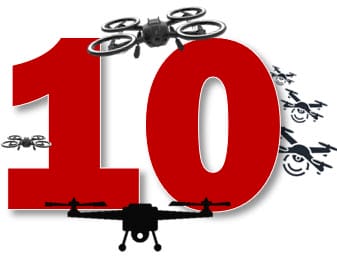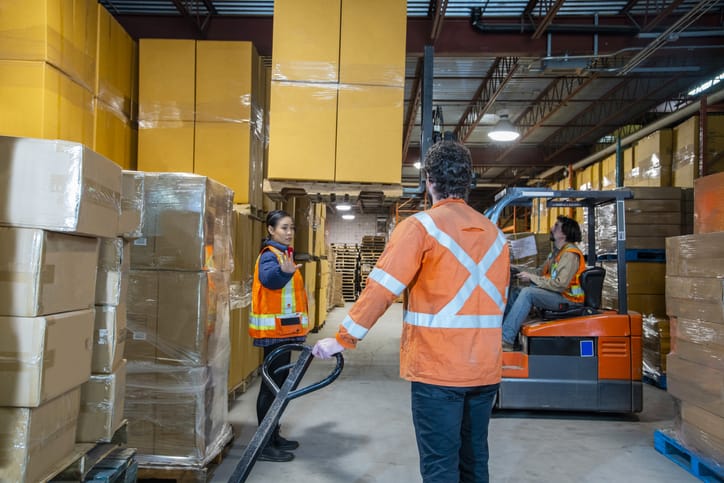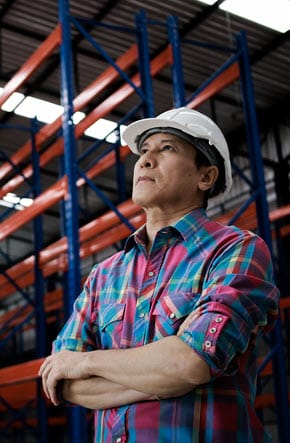Your browser is out of date, for the best web viewing experience visit Browse Happy to upgrade your browser today.
By Craig Dowley
First introduced in the mid-2010’s, warehouse drones (or UAVs) have become more accepted as an option to solve cycle counting challenges. Warehouses considering drones do so in an effort to increase inventory accuracy and also reduce costs by trimming cycle count headcount. Before considering these aerial robots it’s important that you understand the challenges you will encounter. These 10 warehouse drone facts are not specific to one solution provider or type of drone, instead these are technology limitations and process requirements inherent in any drone delegated to cycle counting tasks.
Learn more about warehouse drones here: Introduction to Warehouse Drones


Warehouse drones are programmed to follow specific routes, which is helpful in enabling independent flights. But do not confuse independence with autonomous. Warehouse workers constantly need to ensure that aisles are cleared of any unexpected equipment, signage, or people. This was a primary driver in the development of StorTRACK, the all-new Vimaan cycle counting solution. StorTRACK is safer, faster, and more efficient than any warehouse drone on the market. Warehouses DO NOT need to clear aisles or any such prep work to successfully operate StorTRACK. StorTRACK can go anywhere your MHE goes..
Along with cleared aisles, warehouse workers also need to ensure the aisles are cleaned and free of any loose debris. Updrafts caused by typical drone flights will suck any lightweight material into the rotors. This includes loose shrink wrap, packing tape, paper labels and corrugate. Due to their low field of view (FOV) and the need to generate high resolution scans, drones need to hover closely and for prolonged periods of time near inventory. All it takes is a few seconds of hover time for a drone to ingest these materials into their rotors. When this happens the drone rotors become entangled, and the drone becomes disabled. Now when a drone gets tangled 30’ off the ground somebody needs to go up and retrieve it. This is not a very autonomous operation. Watch this video to see what happens when a drone gets close to loose shrink wrap.

There is no hiding this weakness. Warehouse drone providers will be very upfront regarding the 20 minute or less battery life of their drones. This will not equate to 20 minutes of cycle counting time; however, keep in mind that the drones need to return to their charge stations or they will fall hard and lay lifeless on your warehouse floor (subject to crushing by an MHE).
One suggestion you might hear is adding more charging stations across the warehouse, requiring the installation of dozens of outlets into the middle of the aisles, which is not very practical. Alternatively, StorTRACK from Vimaan is capable of operating for 8 hours without requiring a new charge.

In an effort to keep drones light, there is a limited amount of equipment weight that can be installed on the vehicle. That’s one of the reasons batteries are so small and the reason why they typically will only include a single camera. While this reduces the weight it also reduces the drone’s Field Of View (FOV). The smaller the FOV, the longer the time required to scan your inventory, especially when the bins are filled with multiple labels that need scanning. To help address the small FOV, drones may scan several feet away from the aisle; but then resolution gets compromised, reducing the effectiveness of shelf scans. Drone solution providers are very upfront about this – drones can be effective in scanning single labels on pallets but when it comes to scanning high-density storage areas, drones are fall short.
As previously mentioned, drones have very short flight times due to battery limitations. Small FOV combined with short battery lives equate to limited parts of your inventory being scanned in a single flight. Vimaan has installed 4 cameras on StorTRACK to quadruple the FOV. When combined with the 8-hour battery charge StorTRACK can provide far greater efficiency of scanning as well as productivity during a single mission, which in turn enables more frequent and thorough cycle count automation.
Most cycle count requirements include scanning a barcode, but if you need to capture more, a drone may not be able to help. For example, if you want to capture inventory quantities, read label text, identify missing labels, inspect for damages, or identify open bins, a flying barcode scanner won’t help. To accomplish these tasks, StorTRACK operates from AI-enabled computer vision that can capture the shelf surroundings and provide a more complete view of your inventory and storage space.
The promise of warehouse drones is that they are “100% autonomous” and can eliminate the need for some headcount. Unfortunately, that hasn’t necessarily come to fruition. While drones have taken over the responsibility of barcode scanning, new duties have arisen that include looking after drones and preparing for their missions. From changing battery packs to making shelves pristine, there is plenty for your workers to do to ensure drones stay in the air. Warehouses that dare to fly multiple drones for prolonged cycle counting find that this is akin to juggling several balls, chainsaws, and lit torches all at once. While it’s true that the all-new StorTRACK from Vimaan requires a single operator, that’s all it needs. No battery charging every 20 minutes, no aisle clearing, and it will take more than a loose strand of shrink wrap to stop StorTRACK from completing its mission.

Preparing a drone to navigate your warehouse takes a lot of work. To support ease of navigation, several tens of thousands of navigation tags needs to be added across your warehouse to ensure a drone knows where it is. Most of these sticker tags require the use of a scissor lift to reach spots your workers can’t. With StorTRACK all you need is a single label at the bottom of your uprights and StorTRACK knows where it is at all times! We have prepared many warehouses for drones, and the set-up time with StorTRACK is 10X faster than our fastest drone installation!
Installation costs with drones are surprisingly high (see “Set Up Time”). These costs are tied to the long set up times for the warehouse, rightly so the solution providers need to ensure they are covering the costs of their installation team and these costs are passed along to their customers. The latest field data has shown that drone installations cost more than double than it would for StorTRACK.
Drones can reach heights a lot easier than workers, but one thing they don’t tell you is that cycle counting with drones is excruciatingly slow. You may see videos of drones zipping around warehouse, those devices are not scanning a single thing. That is all for show, because of their low FOV and need to generate high resolution scans. Because of motion blur, drones need to spend sufficient time on each bin ensuring adequate data capture.
A congested bin full of items could take a drone a few minutes to capture all the labels, meanwhile StorTRACK scans as fast as the MHE can lift it. What would take a drone 60 seconds, takes StorTRACK less than 5 seconds. And don’t forget the limited battery life, this combined with small FOV makes for painfully long scan times to capture a single aisle. StorTRACK scans a 300’ long by 30’ high aisle in less than 60 minutes with over 7 hours of battery charge remaining. Scanning the same aisle, a drone would take over 5 hours and 15 battery changes!

The idea of deploying drones to conduct routine warehouse jobs sounds like a leading-edge innovation. Peers and the media may admire your use of revolutionary tech, but drones are more of a baby step forward in re-thinking the way we tackle labor intensive tasks. Warehouse managers that have deployed drones encounter a whole new set of challenges including their inability to support high density storage scanning and very narrow aisle (VNA) cycle counting. When warehouse managers discover these shortcomings the coolness factor wears off fast. Vimaan has applied lessons learned and groundbreaking computer vision to develop StorTRACK, a smarter way to get cycle counting done right.
The concept of warehouse drones was sound, but in reality, the technology challenges and added maintenance have made them problematic. The learnings of deploying more drone installations than any other North American solution providers has steered Vimaan to a faster, more reliable, and cost-effective cycle counting solution in StorTRACK. For more information contact our Solutions Team for a virtual demo live from our HQ Innovation Center.
Learn more about warehouse drones here: Introduction to Warehouse Drones
Traditional inventory cycle counting processes are expensive, time consuming and are labor intensive. Download this 24-page resource to discover the inventory auditing practices that are helping leading warehouses reach their targeted inventory accuracy levels, while lowering headcount requirements and overall operational costs.